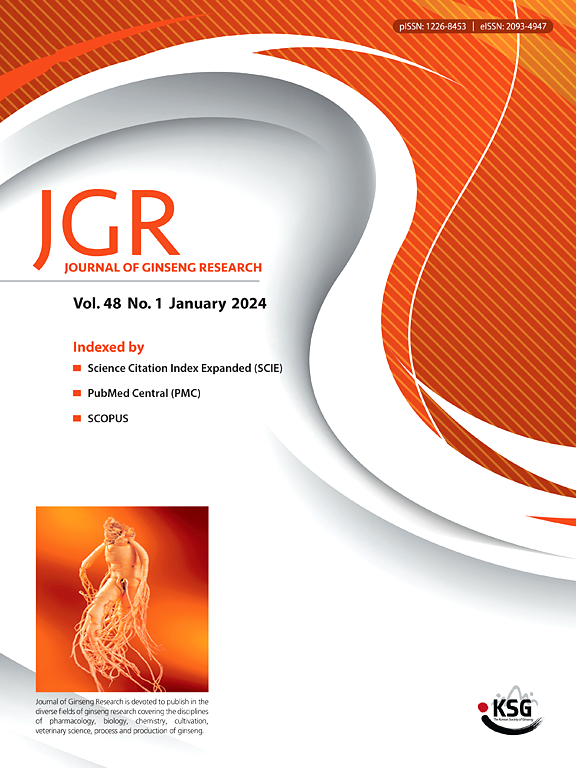人参茎叶转化的稀有人参皂苷通过REGγ负调控PKA/CREB通路促进白色脂肪褐化,从而逆转肥胖
IF 6.8
2区 医学
Q1 CHEMISTRY, MEDICINAL
引用次数: 0
摘要
白色脂肪组织(WAT)褐变可以促进产热,可能是治疗肥胖的一个有希望的靶点。从人参茎叶转化而来的稀有人参皂苷(T-GSSL)具有多种生物活性。然而,其潜在的抗肥胖作用和潜在的机制在很大程度上仍然未知。方法选择5种氨基酸作为催化人参皂苷转化为稀有人参皂苷的催化剂。采用高脂饲料(HFD)饲养14周,建立肥胖小鼠模型。通过测量体重、脂肪量、能量消耗(EE)和葡萄糖耐量来评估T-GSSL对肥胖小鼠的影响。将3T3-L1细胞分化为成熟脂肪细胞,用T-GSSL孵育。采用免疫组织化学、共免疫沉淀法(Co-IP)、酶联免疫吸附法(ELISA)、免疫印迹法(WB)、实时聚合酶链反应(PCR)等方法研究T-GSSL的作用靶点和作用机制。结果以谷氨酸为催化剂水解人参皂苷,制得12种稀有人参皂苷,总转化率达95%。T-GSSL改善了肥胖小鼠的代谢紊乱、脂质异位沉积和肥胖,并维持了葡萄糖稳态。T-GSSL处理促进HFD小鼠和3T3-L1细胞的脂肪褐变和EE增强。在蛋白激酶a (PKA)拮抗剂处理或PKAcα敲低的细胞中,这些作用减弱,而在REGγ−/−小鼠中则增加。REGγ的抑制和PKA/CREB通路的激活阐明了T-GSSL通过促进脂肪组织褐变逆转肥胖的机制。结论st - gssl通过抑制REGγ和随后激活PKA/CREB通路来促进脂肪褐变,从而减轻饮食诱导的肥胖。本文章由计算机程序翻译,如有差异,请以英文原文为准。

Rare ginsenosides transformed from stems and leaves of Panax ginseng reverse obesity by promoting browning of white fat through PKA/CREB pathway via REGγ negative regulation
Background
White adipose tissue (WAT) browning can promote thermogenesis and could be a promising target for treating obesity. Rare ginsenosides transformed from stems and leaves of Panax ginseng (T-GSSL) exhibit numerous biological activities. However, its potential anti-obesity effects and underlying mechanism remain largely unknown.
Methods
Five amino acids were selected as the catalysts for the transformation of ginsenosides into rare ginsenosides. An obese mouse model was established by feeding mice a high-fat diet (HFD) for 14 weeks. The effects of T-GSSL on obese mice were assessed by measuring body weight, fat mass, energy expenditure (EE), and glucose tolerance. The 3T3-L1 cells were differentiated into mature adipocytes and incubated with T-GSSL. Immunohistochemistry, co-immunoprecipitation (Co-IP), enzyme-linked immunosorbent assays (ELISA), western blotting (WB), real-time polymerase chain reaction (PCR), and other methods were used to investigate the targets and mechanisms of action of T-GSSL.
Results
Ginsenosides in GSSL were hydrolyzed using glutamic acid as a catalyst and 12 rare ginsenosides were produced, with a total conversion rate of 95 %. T-GSSL ameliorated metabolic disorders, lipid ectopic deposition, and obesity, and maintained glucose homeostasis in obese mice. T-GSSL treatment promoted adipose browning and enhanced EE in both HFD mice and 3T3-L1 cells. These effects were decreased in cells treated with a protein kinase A (PKA) antagonist or subjected to PKAcα knockdown, whereas they were increased in REGγ−/− mice. The inhibition of REGγ alongside the activation of the PKA/CREB pathway elucidates the mechanism through which T-GSSL reverses obesity by promoting the browning of adipose tissue.
Conclusions
T-GSSL attenuates diet-induced obesity by promoting adipose browning through the inhibition of REGγ and subsequent activation of the PKA/CREB pathway.
求助全文
通过发布文献求助,成功后即可免费获取论文全文。
去求助
来源期刊

Journal of Ginseng Research
CHEMISTRY, MEDICINAL-INTEGRATIVE & COMPLEMENTARY MEDICINE
CiteScore
11.40
自引率
9.50%
发文量
111
审稿时长
6-12 weeks
期刊介绍:
Journal of Ginseng Research (JGR) is an official, open access journal of the Korean Society of Ginseng and is the only international journal publishing scholarly reports on ginseng research in the world. The journal is a bimonthly peer-reviewed publication featuring high-quality studies related to basic, pre-clinical, and clinical researches on ginseng to reflect recent progresses in ginseng research.
JGR publishes papers, either experimental or theoretical, that advance our understanding of ginseng science, including plant sciences, biology, chemistry, pharmacology, toxicology, pharmacokinetics, veterinary medicine, biochemistry, manufacture, and clinical study of ginseng since 1976. It also includes the new paradigm of integrative research, covering alternative medicinal approaches. Article types considered for publication include review articles, original research articles, and brief reports.
JGR helps researchers to understand mechanisms for traditional efficacy of ginseng and to put their clinical evidence together. It provides balanced information on basic science and clinical applications to researchers, manufacturers, practitioners, teachers, scholars, and medical doctors.
 求助内容:
求助内容: 应助结果提醒方式:
应助结果提醒方式:


